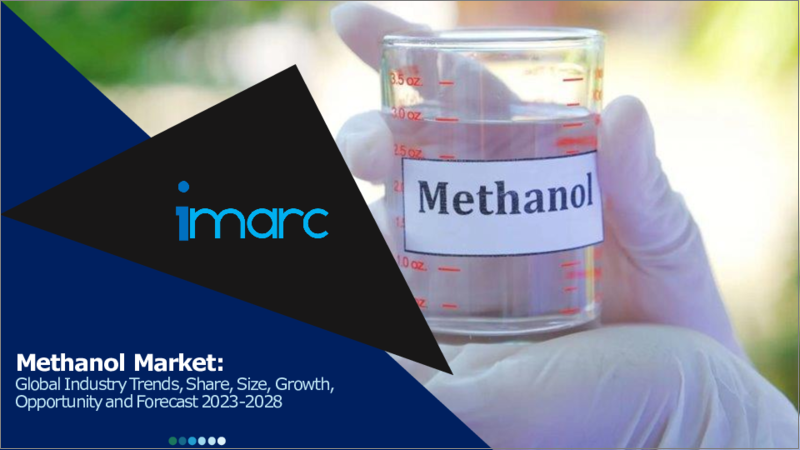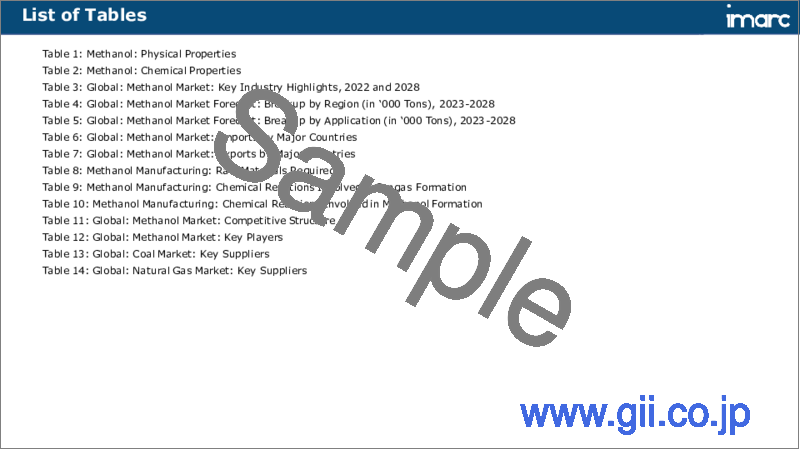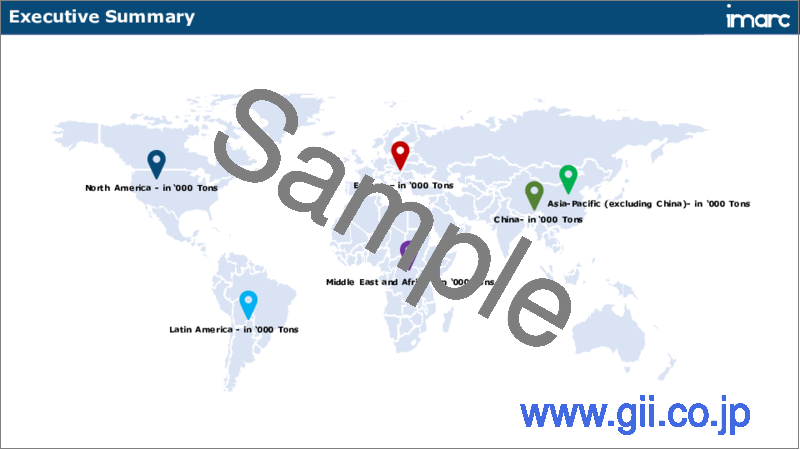|
|
市場調査レポート
商品コード
1298528
メタノール市場:世界の産業動向、シェア、規模、成長機会、2023-2028年予測Methanol Market: Global Industry Trends, Share, Size, Growth, Opportunity and Forecast 2023-2028 |
||||||
|
● お客様のご希望に応じて、既存データの加工や未掲載情報(例:国別セグメント)の追加などの対応が可能です。 詳細はお問い合わせください。 |
|||||||
| メタノール市場:世界の産業動向、シェア、規模、成長機会、2023-2028年予測 |
|
出版日: 2023年06月14日
発行: IMARC
ページ情報: 英文 142 Pages
納期: 2~3営業日
|
- 全表示
- 概要
- 図表
- 目次
市場概要:
世界のメタノール市場規模は2022年に345億米ドルに達しました。今後、IMARC Groupは、市場は2023年から2028年の間に5.1%の成長率(CAGR)を示し、2028年までに470億米ドルに達すると予測しています。
メタノール(CH3OH)は、一般に木質アルコールとして知られ、独特の臭いを持つ無色透明で揮発性の液体アルコールです。最も単純なアルコールで、メチル基とヒドロキシ基が結合したものです。以前は木材の破壊的蒸留によって製造されていたが、現在では触媒の存在下で一酸化炭素ガスと水素を直接結合させることによってメタノールが調製されます。蒸発率や放射熱エネルギーが低いだけでなく、水、アルコール、エーテル、ケトンなどのさまざまな溶媒に混和します。こうした特性から、一般溶剤として、また樹脂、医薬品、香水の製造に広く使用されています。
市場促進要因:
メタノールは入手が容易で非常に効率的であるため、自動車産業では輸送用燃料や自動車のラジエーター用不凍液として広く使用されています。これに加えて、従来のガソリンに代わる安全な代替燃料であるジメチルエーテル(DME)やメチルtert-ブチルエーテル(MTBE)の製造にも使用されています。また、バイオディーゼルの必須成分となり、内燃機関で使用されます。これ以外にも、アルコールはホルムアルデヒド、酢酸、酢酸メチルの製造にも多く使われています。これらの化学物質はさらに、接着剤、塗料、合板、溶剤、発泡体、プラスチック、爆薬の製造にも使われます。さらに、メタノールは生分解が容易で環境に優しいため、原油、ガソリン、ディーゼルなどの代替品よりも好まれています。
本レポートで扱う主な質問
- 2022年のメタノールの世界市場規模は?
- 予測期間(2023-2028年)におけるメタノールの世界市場展望は?
- メタノールの世界市場の促進要因は?
- メタノールの世界市場における主要動向は?
- メタノールの世界市場におけるCOVID-19の影響は?
- メタノールの世界市場における用途別区分は?
- メタノールの世界市場における主要地域は?
目次
第1章 序文
第2章 調査範囲と調査手法
- 調査目的
- 利害関係者
- データソース
- 一次情報
- 二次情報
- 市場推定
- ボトムアップアプローチ
- トップダウンアプローチ
- 調査手法
第3章 エグゼクティブサマリー
第4章 イントロダクション
- 概要
- 物理的・化学的特性
- 主要産業動向
第5章 世界のメタノール産業
- 市場概要
- 市場実績
- 数量動向
- 金額動向
- COVID-19の影響
- 価格動向
- 主な価格指標
- 価格構造
- 価格動向
- 市場予測
- SWOT分析
- 概要
- 強み
- 弱み
- 機会
- 脅威
- バリューチェーン分析
- 概要
- 原材料の採掘と抽出
- 製造
- マーケティング
- 流通
- 輸出
- 最終用途
- マージン分析
- ポーターのファイブフォース分析
- 概要
- 買い手の交渉力
- 供給企業の交渉力
- 競合の程度
- 新規参入業者の脅威
- 代替品の脅威
- 貿易データ
- 輸入
- 輸出
- 市場促進要因と成功要因
第6章 主要地域の業績
- 中国
- 市場動向
- 市場予測
- アジア太平洋(中国を除く)
- 市場動向
- 市場予測
- 欧州
- 市場動向
- 市場予測
- 北米
- 市場動向
- 市場予測
- ラテンアメリカ
- 市場動向
- 市場予測
- 中東・アフリカ
- 市場動向
- 市場予測
第7章 市場内訳:用途別
- ホルムアルデヒド
- 市場動向
- 市場予測
- ジメチルエーテル
- 市場動向
- 市場予測
- ガソリン
- 市場動向
- 市場予測
- クロロメタン
- 市場動向
- 市場予測
- MTBE/TAME
- 市場動向
- 市場予測
- 酢酸
- 市場動向
- 市場予測
- その他
- 市場動向
- 市場予測
第8章 競合情勢
- 市場構造
- 市場内訳:主要プレーヤー別
- 主要プレーヤーのプロファイル
第9章 メタノールの製造プロセス
- 製品概要
- 関与する化学反応
- 詳細なプロセスフロー
- 原材料の要件
- マスバランスと原料転換率
第10章 メタノール原料分析
- 石炭
- 市場実績
- 数量動向
- 価格の動向
- 価格動向
- 市場内訳:地域別
- 市場内訳:用途別
- 市場実績
- 天然ガス
- 市場実績
- 数量動向
- 価格動向
- 価格動向
- 市場内訳:地域別
- 市場内訳:用途別
- 市場実績
List of Figures
- Figure 1: Global: Methanol Market: Major Drivers and Challenges
- Figure 2: Global: Methanol Market: Volume Trends (in Million Tons), 2017-2022
- Figure 3: Global: Methanol Market: Value Trends (in Billion US$), 2017-2022
- Figure 4: Global: Methanol Market: Average Prices (in US$/Ton), 2017-2022
- Figure 5: Global: Methanol Market Forecast: Volume Trends (in Million Tons), 2023-2028
- Figure 6: Global: Methanol Market Forecast: Value Trends (in Billion US$), 2023-2028
- Figure 7: Global: Methanol Market Forecast: Average Prices (in US$/Ton), 2023-2028
- Figure 8: Global: Methanol Market: Price Structure
- Figure 9: Global: Methanol Industry: SWOT Analysis
- Figure 10: Global: Methanol Industry: Value Chain Analysis
- Figure 11: Global: Methanol Industry: Profit Margin at Various Level of Supply Chain
- Figure 12: Global: Methanol Industry: Porter's Five Forces Analysis
- Figure 13: Global: Methanol Market: Breakup by Region (in %), 2022
- Figure 14: China: Methanol Market (in '000 Tons), 2017 & 2022
- Figure 15: China: Methanol Market Forecast (in '000 Tons), 2023-2028
- Figure 16: Asia Pacific (Excluding China): Methanol Market (in '000 Tons), 2017 & 2022
- Figure 17: Asia Pacific (Excluding China): Methanol Market Forecast (in '000 Tons), 2023-2028
- Figure 18: Europe: Methanol Market (in '000 Tons), 2017 & 2022
- Figure 19: Europe: Methanol Market Forecast (in '000 Tons), 2023-2028
- Figure 20: North America: Methanol Market (in '000 Tons), 2017 & 2022
- Figure 21: North America: Methanol Market Forecast (in '000 Tons), 2023-2028
- Figure 22: Latin America: Methanol Market (in '000 Tons), 2017 & 2022
- Figure 23: Latin America: Methanol Market Forecast (in '000 Tons), 2023-2028
- Figure 24: Middle East and Africa: Methanol Market (in '000 Tons), 2017 & 2022
- Figure 25: Middle East and Africa: Methanol Market Forecast (in '000 Tons), 2023-2028
- Figure 26: Global: Methanol Market: Breakup by Application (in %), 2022
- Figure 27: Global: Methanol Market: Formaldehyde (in '000 Tons), 2017 & 2022
- Figure 28: Global: Methanol Market Forecast: Formaldehyde (in '000 Tons), 2023-2028
- Figure 29: Global: Methanol Market: Dimethyl Ether (in '000 Tons), 2017 & 2022
- Figure 30: Global: Methanol Market Forecast: Dimethyl Ether (in '000 Tons), 2023-2028
- Figure 31: Global: Methanol Market: Gasoline (in '000 Tons), 2017 & 2022
- Figure 32: Global: Methanol Market Forecast: Gasoline (in '000 Tons), 2023-2028
- Figure 33: Global: Methanol Market: Chloromethane (in '000 Tons), 2017 & 2022
- Figure 34: Global: Methanol Market Forecast: Chloromethane (in '000 Tons), 2023-2028
- Figure 35: Global: Methanol Market: MTBE/TAME (in '000 Tons), 2017 & 2022
- Figure 36: Global: Methanol Market Forecast: MTBE/TAME (in '000 Tons), 2023-2028
- Figure 37: Global: Methanol Market: Acetic Acid (in '000 Tons), 2017 & 2022
- Figure 38: Global: Methanol Market Forecast: Acetic Acid (in '000 Tons), 2023-2028
- Figure 39: Global: Methanol Market: Other Applications (in '000 Tons), 2017 & 2022
- Figure 40: Global: Methanol Market Forecast: Other Applications (in '000 Tons), 2023-2028
- Figure 41: Global: Methanol Market: Share of Key Players (in %), 2022
- Figure 42: Methanol Manufacturing: Detailed Process Flow
- Figure 43: Methanol Manufacturing: Conversion Rate of Feedstocks
- Figure 44: Global: Coal Market: Production Volume Trends (in Million Tons), 2017-2022
- Figure 45: Global: Coal Market: Value Trends (in '000 US$), 2017-2022
- Figure 46: Global: Coal Market: Average Prices (in US$/Ton), 2017-2022
- Figure 47: Global: Coal Market: Breakup by Region (in %), 2022
- Figure 48: Global: Coal Market: Breakup by Application (in %), 2022
- Figure 49: Global: Natural Gas Market: Production Volume Trends (in Million Tons), 2017-2022
- Figure 50: Global: Natural Gas Market: Value Trends (in '000 US$), 2017-2022
- Figure 51: Global: Natural Gas Market: Average Prices (in US$/Ton), 2017-2022
- Figure 52: Global: Natural Gas Market: Breakup by Region (in %), 2022
- Figure 53: Global: Natural Gas Market: Breakup by Application (in %), 2022
List of Tables
- Table 1: Methanol: Physical Properties
- Table 2: Methanol: Chemical Properties
- Table 3: Global: Methanol Market: Key Industry Highlights, 2022 and 2028
- Table 4: Global: Methanol Market Forecast: Breakup by Region (in '000 Tons), 2023-2028
- Table 5: Global: Methanol Market Forecast: Breakup by Application (in '000 Tons), 2023-2028
- Table 6: Global: Methanol Market: Imports by Major Countries
- Table 7: Global: Methanol Market: Exports by Major Countries
- Table 8: Methanol Manufacturing: Raw Materials Required
- Table 9: Methanol Manufacturing: Chemical Reactions Involved in Syngas Formation
- Table 10: Methanol Manufacturing: Chemical Reactions Involved in Methanol Formation
- Table 11: Global: Methanol Market: Competitive Structure
- Table 12: Global: Methanol Market: Key Players
- Table 13: Global: Coal Market: Key Suppliers
- Table 14: Global: Natural Gas Market: Key Suppliers
Market Overview:
The global methanol market size reached US$ 34.5 Billion in 2022. Looking forward, IMARC Group expects the market to reach US$ 47.0 Billion by 2028, exhibiting a growth rate (CAGR) of 5.1% during 2023-2028.
Methanol (CH3OH), commonly known as wood alcohol, is a light, colorless and volatile liquid alcohol with a distinctive odor. It is the simplest type of alcohol and consists of a methyl group linked with a hydroxy group. Earlier produced by the destructive distillation of wood, methanol is now prepared by directly combining carbon monoxide gas and hydrogen in the presence of a catalyst. It not only has a low rate of evaporation and radiant heat energy but is also miscible in different solvents like water, alcohol, ether and ketones. On account of these properties, it is widely used as a general solvent and to produce resins, pharmaceuticals and perfumes.
Market Drivers:
Since methanol is readily available and extremely efficient, it is extensively used in the automotive industry as a transportation fuel and antifreeze agent for automobile radiators. In addition to this, it is employed in the manufacturing of Dimethyl ether (DME) and Methyl tert-butyl ether (MTBE), which are safer alternatives to traditional gasoline. It also forms an essential component of biodiesel and is used in internal combustion engines. Apart from this, the alcohol also finds numerous applications in the manufacturing of formaldehyde, acetic acid and methyl acetate. These chemicals are further used in the production of adhesives, paints, plywood, solvents, foams, plastics and explosives. Furthermore, since methanol biodegrades easily and is eco-friendly in nature, it is preferred over counterparts like crude oil, gasoline and diesel.
Key Market Segmentation:
IMARC Group provides an analysis of the key trends in each sub-segment of the global methanol market report, along with forecasts at the global and regional level from 2023-2028. Our report has categorized the market based on application.
Breakup by Application:
- Formaldehyde
- Dimethyl ether
- Gasoline
- Chloromethane
- MTBE/TAME
- Acetic acid
- Others
Formaldehyde is the largest application segment as it is largely used for the manufacturing of plywood, plastics and paints. Moreover, it is also used as a fuel on account of its remarkable blending attributes.
Regional Insights:
- China
- Asia-Pacific (excluding China)
- Europe
- North America
- Latin America
- Middle East and Africa
On the geographical front, China enjoys the leading position in the global market on account of growing demand for methanol-gasoline blends in the region.
Competitive Landscape:
The competitive landscape of the market has also been analyzed with the detailed profiles of the key player operating in the market.
The essential aspects of the methanol market evaluated in the report include:
- Market trends
- Major regions
- Key application areas
- Key manufacturers
- Price trends
- Raw material requirements
- Chemical reactions involved in the manufacturing process
- Major importers and exporters
- Value chain analysis
- Market trends for major feedstocks
- Price trends for major feedstocks
- Key regions for major feedstocks
- Key application areas for major feedstocks
Key Questions Answered in This Report:
- What was the global methanol market size in 2022?
- What will be the global methanol market outlook during the forecast period (2023-2028)?
- What are the global methanol market drivers?
- What are the major trends in the global methanol market?
- What is the impact of COVID-19 on the global methanol market?
- What is the global methanol market breakup by application?
- What are the major regions in the global methanol market?
Table of Contents
1 Preface
2 Scope and Methodology
- 2.1 Objectives of the Study
- 2.2 Stakeholders
- 2.3 Data Sources
- 2.3.1 Primary Sources
- 2.3.2 Secondary Sources
- 2.4 Market Estimation
- 2.4.1 Bottom-Up Approach
- 2.4.2 Top-Down Approach
- 2.5 Forecasting Methodology
3 Executive Summary
4 Introduction
- 4.1 Overview
- 4.2 Physical and Chemical Properties
- 4.3 Key Industry Trends
5 Global Methanol Industry
- 5.1 Market Overview
- 5.2 Market Performance
- 5.2.1 Volume Trends
- 5.2.2 Value Trends
- 5.3 Impact of COVID-19
- 5.4 Price Trends
- 5.4.1 Key Price Indicators
- 5.4.2 Price Structure
- 5.4.3 Price Trends
- 5.5 Market Forecast
- 5.6 SWOT Analysis
- 5.6.1 Overview
- 5.6.2 Strengths
- 5.6.3 Weaknesses
- 5.6.4 Opportunities
- 5.6.5 Threats
- 5.7 Value Chain Analysis
- 5.7.1 Overview
- 5.7.2 Raw Material Mining and Extraction
- 5.7.3 Manufacturing
- 5.7.4 Marketing
- 5.7.5 Distribution
- 5.7.6 Export
- 5.7.7 End Use
- 5.8 Margin Analysis
- 5.9 Porter's Five Forces Analysis
- 5.9.1 Overview
- 5.9.2 Bargaining Power of Buyers
- 5.9.3 Bargaining Power of Suppliers
- 5.9.4 Degree of Competition
- 5.9.5 Threat of New Entrants
- 5.9.6 Threat of Substitutes
- 5.10 Trade Data
- 5.10.1 Imports
- 5.10.2 Exports
- 5.11 Key Market Drivers and Success Factors
6 Performance of Key Regions
- 6.1 China
- 6.1.1 Market Trends
- 6.1.2 Market Forecast
- 6.2 Asia Pacific (Excluding China)
- 6.2.1 Market Trends
- 6.2.2 Market Forecast
- 6.3 Europe
- 6.3.1 Market Trends
- 6.3.2 Market Forecast
- 6.4 North America
- 6.4.1 Market Trends
- 6.4.2 Market Forecast
- 6.5 Latin America
- 6.5.1 Market Trends
- 6.5.2 Market Forecast
- 6.6 Middle East and Africa
- 6.6.1 Market Trends
- 6.6.2 Market Forecast
7 Market Breakup by Application
- 7.1 Formaldehyde
- 7.1.1 Market Trends
- 7.1.2 Market Forecast
- 7.2 Dimethyl Ether
- 7.2.1 Market Trends
- 7.2.2 Market Forecast
- 7.3 Gasoline
- 7.3.1 Market Trends
- 7.3.2 Market Forecast
- 7.4 Chloromethane
- 7.4.1 Market Trends
- 7.4.2 Market Forecast
- 7.5 MTBE/TAME
- 7.5.1 Market Trends
- 7.5.2 Market Forecast
- 7.6 Acetic Acid
- 7.6.1 Market Trends
- 7.6.2 Market Forecast
- 7.7 Others
- 7.7.1 Market Trends
- 7.7.2 Market Forecast
8 Competitive Landscape
- 8.1 Market Structure
- 8.2 Market Breakup by Key Players
- 8.3 Key Player Profiles
9 Methanol Manufacturing Process
- 9.1 Product Overview
- 9.2 Chemical Reactions Involved
- 9.3 Detailed Process Flow
- 9.4 Raw Material Requirements
- 9.5 Mass Balance and Feedstock Conversion Rates
10 Methanol: Feedstock Analysis
- 10.1 Coal
- 10.1.1 Market Performance
- 10.1.1.1 Volume Trends
- 10.1.1.2 Value Trends
- 10.1.2 Price Trends
- 10.1.3 Market Breakup by Region
- 10.1.4 Market Breakup by Application
- 10.1.1 Market Performance
- 10.2 Natural Gas
- 10.2.1 Market Performance
- 10.2.1.1 Volume Trends
- 10.2.1.2 Value Trends
- 10.2.2 Price Trends
- 10.2.3 Market Breakup by Region
- 10.2.4 Market Breakup by Application
- 10.2.1 Market Performance




